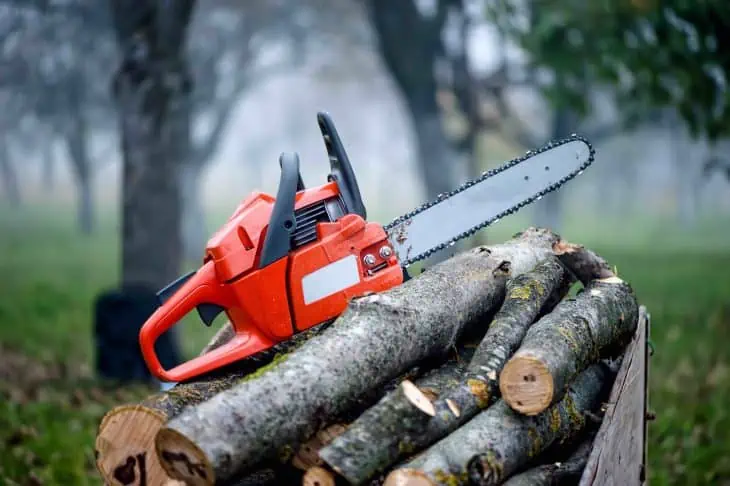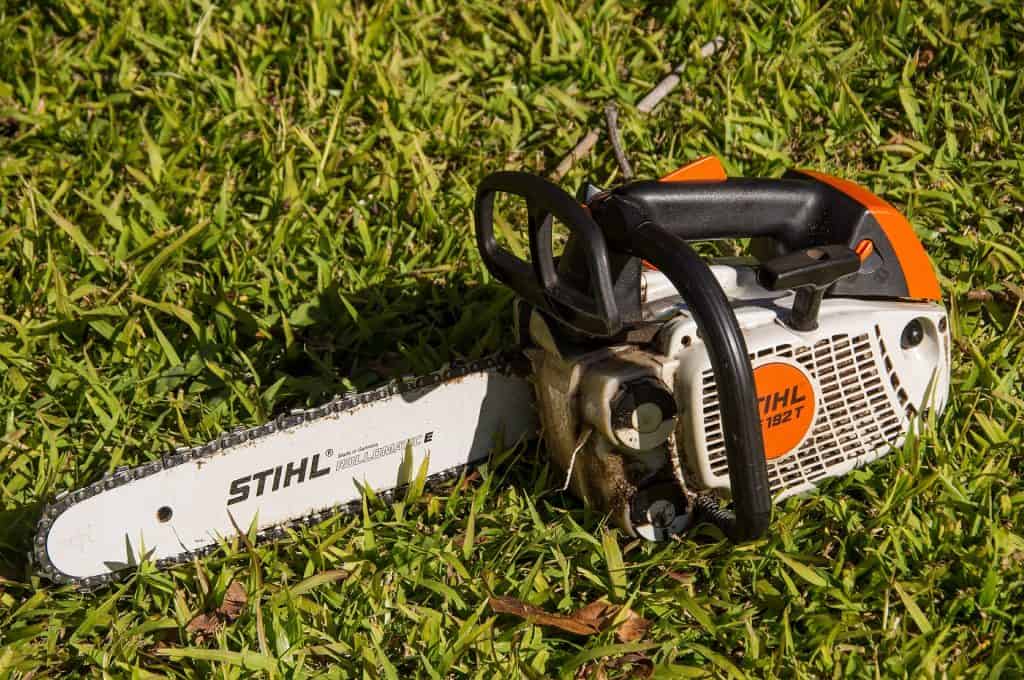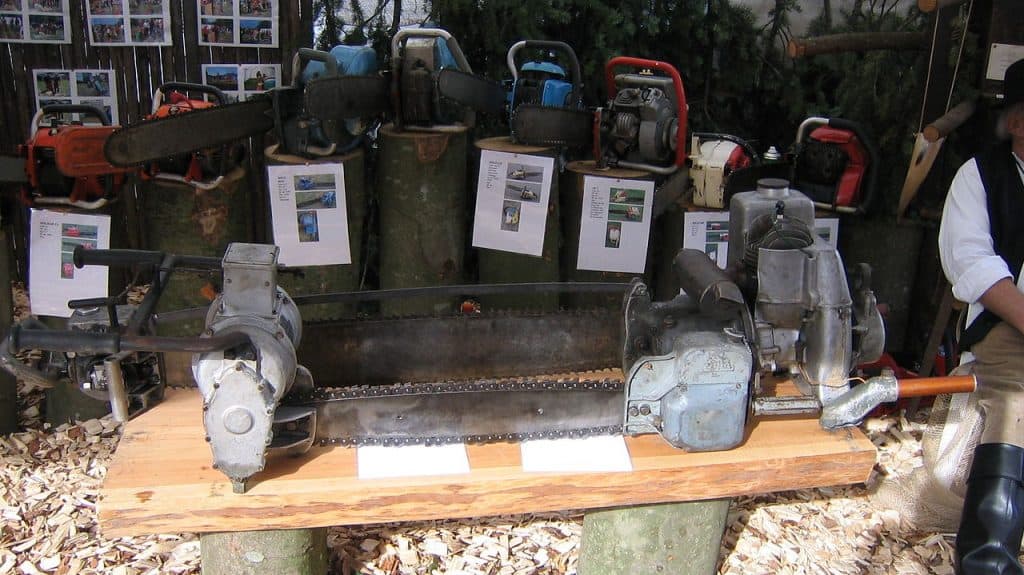
The handheld machine we know is big and dangerous. It’s the lumberjack’s tool to cut down trees and it’s a woodworking essential. But other than that, the chainsaw is probably one of the most versatile machines ever invented. It can be used for wood, bricks, concrete, and most surprisingly, as a surgical tool! The chainsaw has evolved ever since with several different types out on the market. Why were chainsaws invented? Who uses it? Is it more than an icon of the horror genre? Continue reading to find out more!
The Chainsaw’s Medical Origins
This probably answers the question, “why were chainsaws invented?” Surprisingly, the machine began in the surgical field. The first chainsaw was actually used for childbirth.
Before a safe cesarean procedure became common, there was symphysiotomy. The Guardian described the medical procedure as “a dangerous alternative” to remove the child from the womb. This type of operation has been around since 1597, but it wasn’t until the 18th century when two Scottish doctors John Aitken and James Jeffray created a small “flexible saw” that consisted of a “fine serrated link chain held between two wooden handles.”
A similar instrument was made in 1830 developed by the German orthopaedist Bernhard Heine called osteotome. It “had links of a chain carrying small cutting teeth” used to cut the bone.
The Timeline of How it Became the Lumberjack’s Best Friend
It’s a little hard to believe that Bernhard Heine’s osteotome was the precursor for the modern chainsaw and it took inventors five decades to create the ideal one for wood-chucking.
On January 17, 1905, the patent for an “endless chainsaw” was granted to Samuel J. Bens. After more than a decade, Canadian millwright James Shand improved the design by making it portable. In 1933, the German company Festo further developed the power tool.
Not long after, Pioneer Saws Ltd of IEL (Industrial Engineering Ltd.) became North America’s chainsaw manufacturer. After World War Two, the chainsaw became lighter and made it possible for one person to carry it around.
Parts of a Chainsaw
“The whole is a sum of its parts,” goes well with chainsaws. Sure, one looks like a two-part machine, but six parts with almost 20 sub-parts actually make it up. Each one is just as important as the other. Instead of answering “why were chainsaws invented?”, let’s ask “what makes a chainsaw work?”

Engine
This is the most essential part of a chainsaw. There are two types of chainsaw engines: the traditional gasoline internal combustion engine that runs on petrol and the electric motor that runs on batteries. Either works well for wood-cutting.
Drive Mechanism
Of course, the engine cannot run without a drive mechanism. The centrifugal clutch (which expands with increasing speed) and the sprocket (which is changeable, depending on what’s needed) are the two most important parts.
Guide Bar
The guide bar is “an elongated bar with a round end of wear-resistant alloy steel typically 40 to 90 cm (16 to 36 in) in length.” There are three different types, namely the laminated bar, the solid bar, and the safety bar. Four smaller parts make it up: the gauge, the oil holes, grease holes at the bar nose, and the guide slot.
Cutting Chain
It’s obviously not a chainsaw without, well, a chain. It’s like a bicycle chain with additional small, sharp cutting teeth. There are two types of chains: full complement (one tooth for every two links) and full skip (one tooth for every three links).
Tensioning Mechanism
The tensioner acts like a glue that “binds” the guider bar and the cutting chain together. According to TimberGadgets.com, the tensioner is “typically located on the opposite side of the chainsaw” and it “controls the amount of tension or slack in the chain.”
Safety Features
Such dangerous machinery needs to be safe for use, of course. Some of the features added are guard links, a chain brake, a safety throttle, an anti-vibration system, and of course, the on/off switch.
Types of Chainsaw
There are five different types of chainsaw, six when including the surgical saw. Even then, it proves that the machine is versatile. The chainsaw has a variety of uses but it is widely and mainly used for wood-cutting.

Gas-powered
Known for being powerful and portable, people who value speed and efficiency usually choose the gas-powered chainsaw. It can survive for decades if maintained well and it only needs simple repairs. The downsides are it’s extremely heavy, produces fuel emissions, and requires the most maintenance care.
Electric or Corded
These are chainsaws that need to be plugged in before use. It’s light and with longer bar lengths. The electric chainsaw is also cheap, quiet, and easy to operate. Its strength is also its weakness since it can’t be used when there’s a power outage and it can only be repaired by a professional.
Battery-operated
Considered as the gas chainsaw’s direct competitor, Chainsaw Larry says the battery-operated chainsaw has “the conveniences of a gas chainsaw but without the burden of using fuel.” This may be the perfect chainsaw for environment enthusiasts because it’s portable, quiet, low maintenance, and has no fuel emissions. But the cons include it weighing heavier, it’s extremely expensive, has shorter cutting times, and longer charging times.
Manual
This is the most un-chainsaw-like out of the types. The manual chainsaw existed before the gas-powered types. It resembles a whip or a dog leash, but with a handle on both ends. It’s portable and cheap, but it requires muscle power.
Pole Saws
It’s basically Harry Potter‘s wand but for thin tree branches. A pole saw is “a chainsaw on a stick” that allows its users to “prune limbs and cut off branches.” It’s inexpensive, lightweight, and easy to manage but is only good for one task.
Oscillating Bone Saw
It’s hard to forget the chainsaw that started it all. This surgical saw is much safer than its ancestor osteotome. Vector Medical, a medical and surgical saw blades manufacturing company, says there’s a different cutting instrument depending on what type of operation there is.
Most Popular Chainsaw Brands
There are three power tool brands that DIY (Do-It-Yourself) Moms and I-Can-Fix-Everything Dads love. It doesn’t necessarily mean it’s affordable, but these three topped the list of the best chainsaw brands in 2020.

Stihl
In 1925, a man named Andreas Stihl invented the first electric saw. By the mid-1970s, he expanded his company by designing home-use equipment, including chainsaws, and sold it in the United States and Brazil.
MSA 200 C0BQ is one of their best chainsaw models because it “is equipped with a powerful yet lightweight brushless motor.” Another brand favorite is the MSE 170 C-BQ, which is best used for trimming and cutting tree branches.
Husqvarna
The brand’s first factory is in Husqvarna, Sweden. They began as a manufacturing company of firearms in 1689. It was in 1959 when they produced their first chainsaw as forestry became prevalent.
The brand recommends different chainsaws for every individual’s needs, such as the compact Husqvarna 120 Mark II for homeowners, the efficient Husqvarna 455 Rancher for all-around use, and the well-performing Husqvarna 545 Mark II for professionals.
Echo
This Japanese brand has been around since 1972, but Yamabiko Corporation has been distributing its products since 2008. ECHO is a reputable brand. Like Backyard Gadget says, it “is considered to be more of a homeowner-grade brand.”
ECHO CS-310 is great for backyard work, while ECHO CS-355T is a specialized in-tree saw. They also recommend their X Series’ CS-620P because it is perfect for felling, bucking, and limbing.
Guinness Book of World Records
Why were chainsaws invented, you ask? To have Guinness Book of World Records entries, of course! There are a dozen of wins under the list but here are some of the notable entries, from the largest one ever built to balancing more than one chainsaw.

World’s Largest Chainsaw
It’s not large for nothing. Standing at 1.83 meters (6 feet) high and 6.98 meters (22 feet and 11 inches) long, Guinness listed Bug Gus as the largest working chainsaw. Moran Iron Works, Inc. made it in 1996, and Da Yoopers Tourist Trap at Ishpeming, Michigan, USA currently displays it.
Most Miniature Chairs Made Using a Chainsaw
The chainsaw has proven itself as one of the best power tools, but one man took it further. On January 28, 2009, Alberto Gonzalez from Madrid, Spain managed to carve eight miniature chairs in three minutes using a chainsaw. How impressive is that?
Longest Time to Balance a Chainsaw on the Forehead
Using a chainsaw with both hands is already difficult, In Boise, Idaho on October 5, 2007, David Rush achieved the world record for the longest duration balancing a chainsaw on the forehead. He successfully balanced the power tool for a second more than five minutes. Amazing!
The Man Who Juggles Chainsaws
In less than a year, Ian Stewart from Canada bagged two Guinness awards by juggling chainsaws. He won the most consecutive chainsaw juggling catches on September 6, 2019. Meanwhile, his next win was the most consecutive under-the-leg chainsaw juggling catches on June 10, 2020.
Chainsaws in News and Popular Culture
The chainsaw may be handy, but be careful as some people became handless while using it. Modern chainsaws have safety features to lessen accidents. Of course, accidents are accidents and they could happen even if you’re careful. The power tool has also appeared on different platforms, from news reports to video games.

On News Reports
Almost 40,000 people experience chainsaw-related injuries and accidents every year, according to AutoAccident.com. It’s not surprising as the power tool is heavy, sharp, and rotates fast. Warshafsky Law listed a few companies, including Stihl and Husqvarna, recalling their chainsaws after causing injuries.
On May 14. 2021, CBSN Boston reported that a 31-year-old tree cutter accidentally cut his arm with a chainsaw. Just barely two months after, a 51-year-old West Sussex firefighter accidentally sliced his leg with the tool, too.
As Seen on Films
Why were chainsaws invented? Not as a murder weapon, obviously. But it’s an entirely different case in the 1974 American film The Texas Chainsaw Massacre. It follows the story of a group of friends who, one by one, fell victim to a chainsaw-wielding maniac and his cannibalistic family.
The character Leatherface carries a large chainsaw. Murderer Ed Gein, who was popular for creating items using sewn human skin, inspired his creation.
In Television Shows
The power tool has appeared several times in different television shows. Chainsaw attacks appear frequently in the American crime drama series Dexter, while a character with a chainsaw for a hand appeared in the children’s cartoon series The Grim Adventures of Billy & Mandy.
In the Black Butler (Kuroshitsuji) anime, the red-haired grim reaper Grell Sutcliff has a customized chainsaw called Deathscythe as a weapon.
As Played in Video Games
Though it appeared several times, chainsaws are not the most common weapon of choice in video games. Obviously, the 1983 Atari game The Texas Chainsaw Massacre has Leatherface.
It also made an appearance in the crime-themed Grand Theft Auto game series. In the Playstation 3 hack-and-slash game called Lollipop Chainsaw, the characters use the chainsaw as a primary weapon.
Was this page helpful?
Our commitment to delivering trustworthy and engaging content is at the heart of what we do. Each fact on our site is contributed by real users like you, bringing a wealth of diverse insights and information. To ensure the highest standards of accuracy and reliability, our dedicated editors meticulously review each submission. This process guarantees that the facts we share are not only fascinating but also credible. Trust in our commitment to quality and authenticity as you explore and learn with us.
